Tasting: 3 (Deceptive) “Rye Smash” Cocktails from WhistlePig
Photos via WhistlePig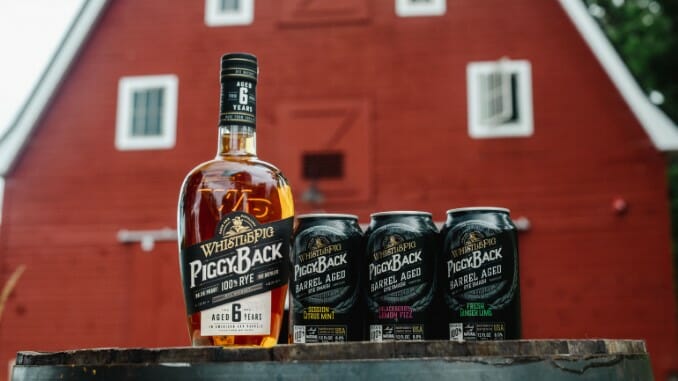
Let me start by saying this for the record: I’ve been a big fan of Vermont’s WhistlePig Rye Whiskey from the very first time I tasted it, almost a decade ago at this point. They make a very high-quality core lineup of whiskey products, with a 100% rye profile that helped their flagship bottle (along with MGP’s 95% rye recipe) redefine the American conception of rye whiskey’s flavor in the 2010s. Before the likes of WhistlePig, American ryes were almost always associated with the 51% rye, “barely legal” style of Kentucky rye, which is a very different animal. WhistlePig, on the other hand, celebrated the spicy, explosively flavorful spirit of the rye grain itself, rather than smoothing away its edges with more bourbon influences. This spicier, more distinctive rye profile has arguably become the standard in American rye whiskey in the process, and a cornerstone of the craft whiskey cocktail revolution. Suffice to say, WhistlePig has produced some deeply influential products, and those whiskeys are still quite delicious today.
However. As time has gone by, WhistlePig has also steadily diversified its interests into other sectors of the alcohol industry, with decidedly mixed results. The latest of these ventures is a new lineup of canned cocktails, which does seem like a no-brainer for WhistlePig. After all, their rye whiskeys have been associated with cocktails for more than a decade—why not mix up some easy canned cocktails and take advantage of the thriving ready-to-drink (RTD) market? But in doing so, WhistlePig has produced something that is at best inauthentic, and at worst deliberately deceptive to the consumer. Suffice to say, I have some serious problems with these “PiggyBack Craft Cocktails,” which also seem to go under the name of WhistlePig PiggyBack Barrel Aged Rye Smash.
I think it’s safe to say that if you surveyed WhistlePig’s consumer base on what they’d be expecting/hoping to get in these cans, they would tell you the following:
— Rye whiskey
— Cocktail mixer ingredients
And indeed, the cans really go out of their way to allow the consumer to make this assumption. They proudly proclaim that they’re made with “100% estate rye,” and the words “barrel aged” pop up repeatedly. The small text on the side of the can describes it as being “made with 100% estate rye and barrel aged fruit.” Unpacking the press sample, I absolutely assumed that this was a canned cocktail made with WhistlePig’s PiggyBack Rye Whiskey brand, which is essentially WhistlePig’s “high value” or budget rye. It wasn’t until I noticed that the word “whiskey” wasn’t appearing anywhere on the can that I started to wonder: Was this actually a hard seltzer I was holding?
Wanting to clarify things, I sent an email to the PR professional who had sent me the cans. “Do these cans actually contain whiskey?”, I asked, half joking. I was fairly confident, even then, that the person would reply that yes, each can is made with PiggyBack Rye Whiskey, the name that appears prominently on the front of the can. I was ready to chalk up the confusion to a few odd choices of marketing and wording. Then the PR person replied with the following: “The cocktail is made from the fermentation of rye malt.” It was only then that I scoured the can and saw, in even smaller writing: “rye malt beverage with natural flavors.”
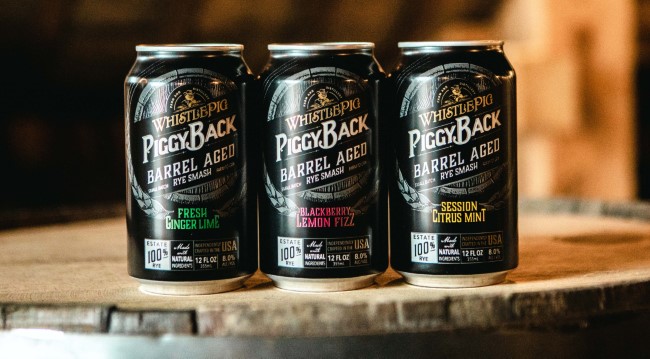 In other words, you might as well think of this product as a hard seltzer, because that’s how the government classifies it.
In other words, you might as well think of this product as a hard seltzer, because that’s how the government classifies it.
Oh. For those who may still not understand what truly defines hard seltzer—not at all surprising, because hard seltzer is inherently confusing—this is essentially how almost all hard seltzers are defined and made. They don’t contain distilled spirits such as whiskey, vodka, tequila or gin, which would make them mixed drinks/canned spirit cocktails in the eyes of U.S. law. Instead, they’re made with alcohol derived from fermentation of sugar or malt, in this case malted rye. This is how seltzers qualify as “malt beverages” similar to beer under U.S. law. It’s an advantageous categorization for companies that produce seltzer, because it allows them to be sold in a much wider range of venues—they can be sold in grocery stores or gas stations, for instance, in many states where spirits/”hard liquor” is only available in package stores. This, coupled with the cost benefits of using alcohol from fermentation rather than distilled spirits, gives hard seltzer an inherent competitive advantage, and it seems that WhistlePig wanted to make use of that advantage when they designed these “cocktails.”
To which I can only reply: Fine, I get the economic incentives here, but you’re a distillery that is famous for rye whiskey and you put the name of your rye whiskey brand on the can! Even the press photo above puts the cans directly next to the bottle of rye whiskey. The potential for consumer confusion is massive, and any cynical person would likely conclude that such deception was the goal. I can only conclude that the casual consumer is meant to look at this can and assume that there’s whiskey in it. If someone like myself, an experienced spirits writer, initially made that assumption, then isn’t it likely a person casually scanning grocery shelves would make the same incorrect conclusion? It’s not like the average consumer pays a ton of attention to these things.
Perplexed and a little annoyed by this response, I wrote back to the WhistlePig PR person, asking point blank for clarification or a statement from the company on the potentially deceptive nature of the packaging and marketing for these canned beverages/seltzers. I wrote the following:
“With the many uses of ‘100% rye’ on the label, does it not seem like many consumers would naturally assume that these drinks contain WhistlePig’s rye whiskey? If a customer described this marketing and packaging as deceptive, how would you respond to that?”
The PR person replied with an attached fact sheet on the product, and no comment from ownership. Perusing the fact sheet, the word “whiskey” appears six times, while the word “cocktail” appears nine times. The words “seltzer” and “malt” appear a grand total of zero times. In all of the PiggyBack Craft Cocktail marketing, meanwhile, I could only find the word “seltzer” in one press release, appearing a single time. Meanwhile, the actual descriptions of the three flavors (Session Citrus Mint, Fresh Ginger Lime, Blackberry Lemon Fizz) on the WhistlePig website say things like the following:
Welcome to Blackberry Lemon Fizz. It’s slightly sweet. Naturally carbonated. And the perfect fruit forward balancing act for the PiggyBack 100% Rye Whiskey notes.
The Session Citrus Mint features the sweetness and tartness of a farm-fresh lemonade balanced with a dose of WhistlePig PiggyBack 100% Rye whiskey notes and a dash of mint.
So, the seltzer contains “100% rye whiskey notes,” but it doesn’t contain any whiskey, huh? Who could possibly be confused by that?
I don’t know what could make the point any more clearly. If you want the consumer to know that your product is a hard seltzer, made with alcohol via the fermentation of malt, then you include that information in the descriptions. You put it front and center on the can. If, in comparison, you want to allow the consumer to jump to the conclusion that the product contains your namesake whiskey, you … well, you do what WhistlePig did here.
With that said, I’m still committed to tasting these and objectively describing them, because that’s what we do at Paste. As previously mentioned, they come in three flavors: Session Citrus Mint, Fresh Ginger Lime, and Blackberry Lemon Fizz, each at 8% ABV. Four packs are available online for purchase at an MSRP of about $17, and they’re currently being sold in Connecticut, Georgia, Massachusetts, Missouri, New Jersey, New York, Pennsylvania, Rhode Island, Tennessee and Vermont, with nationwide expansion coming later this year. Let’s give each a taste.
Session Citrus Mint
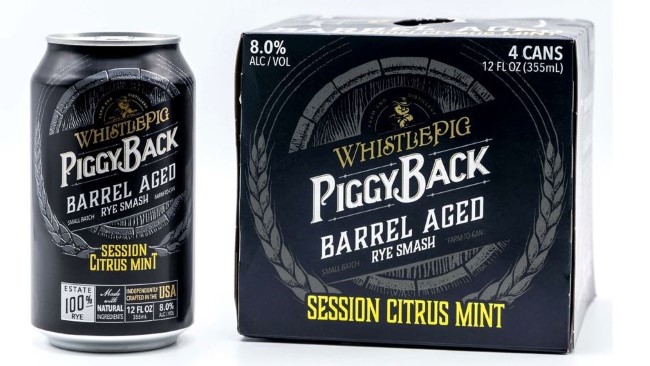
I’m really not sure what “session” is meant to imply in this context—is it a reference to the idea of session beers? Those are inherently low in alcohol, so how would this 8% ABV hard seltzer qualify? Maybe it’s just meant to imply that this is easy to drink? Regardless, the flavors here are obviously replicating the classic smash cocktail, with the lemon citrus and mint additions.
On the nose, the mint and lemonade notes are easy to detect, giving it a julep-like vibe, with an underlying musty, grainy, and slightly boozy note that is a little bit medicinal but not too distracting overall. On the palate, the lemon is nicely tart, bright and piercing, while the mint is more reserved—well conceived, as too much would likely give it the vibe of toothpaste. The mint crops up nicely throughout, but the overall presentation is quite sweet. All in all, this one would likely perform quite well poured over ice, at an ABV that could honestly be dangerous to someone who is effortlessly downing these. Of the three flavors, I found this to be the most drinkable, though the overall sweetness level will limit it to drinkers who aren’t looking for dry.
In short: Pretty decent, actually, though it would probably be that much better with actual whiskey in it.
Fresh Ginger Lime
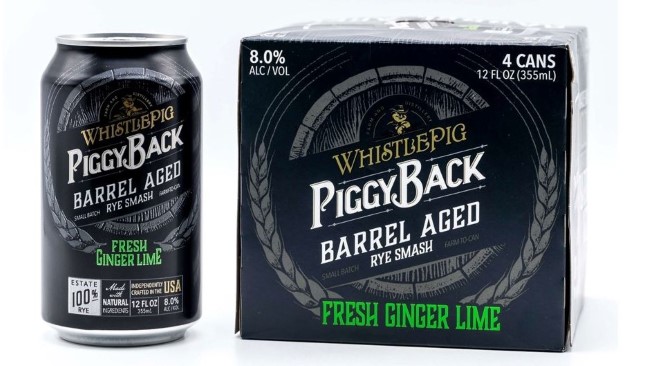
The Fresh Ginger Lime flavor of PiggyBack Craft Cocktail is obviously a play on the mule—I’d say the Kentucky Mule, but it’s more like the Vermont Rye Mule. On the nose, it gives off a lot of ginger ale and musty grain notes, while also having a nice, clear strain of lime. The ginger quality is reminiscent of sweet stem ginger more than anything particularly spicy—this isn’t going to bring that ginger heat. On the palate, there’s plenty of ginger flavor, though this reads as perhaps another step sweeter than the Session Citrus Mint, to the point of becoming slightly cloying.
Ultimately, though, the alcohol flavor in the Fresh Ginger Lime is the worst aspect of this drink—it would probably taste better as a mocktail, without the dusty rye grain/sweet beer wort flavors being delivered by alcohol from rye malt fermentation. And it goes without saying that actual whiskey would probably taste better as well. This cocktail still tastes okay, despite the sweetness, but it’s easy to imagine a superior version that would have incorporated WhistlePig’s namesake spirit.
Blackberry Lemon Fizz
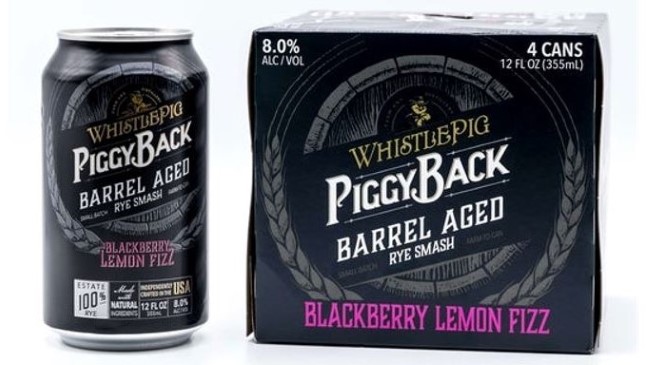
This one is where things finally go off the rails. The Blackberry Lemon Fizz, which has the slightest pink/peach hue to it when poured, fully falls into the uncanny valley of booze. The nose is reminiscent of a grape-flavored Dum Dum Lollipop, which carries over into a grape soda-like palate that is intensely sweet and syrupy. The lemon, meanwhile, gives the drink acidity, but the lemon flavor itself is somehow absent, resulting in a tart but saccharine dark fruity mess.
Suffice to say, only committed fans of fruit-flavored malternative beverages will find the Blackberry Lemon Fizz of interest, but ironically they won’t know to try this product … because they’ll probably think it contains rye whiskey.
Maybe in the future, we can simply label hard seltzers as seltzers, and make things clearer for everyone involved?
Jim Vorel is a Paste staff writer and resident liquor geek. You can follow him on Twitter for more drink writing.







































